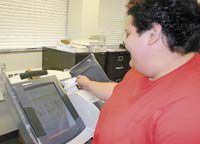| Sulika Merrell demonstrates how to slip a card encoded for the balloting process into one of the voting machines that will be set up around the county next week for a trial run. Voters in the Nov. 8 election will use punch ballots for the last time. Next year, the electronic machines will be used to complete the elective process. |
Almost all Carbon County voters knows what a “hanging chad” is. The term became familiar to citizens who followed the 2000 presidential election because it was an item of controversy at the time.
Since then, states and voting officials have been trying to find a way to make elections and the ballots that people cast more accurate. Enter the electronic voting machine.
Up until 2005, the people of many states and counties, including Carbon, have used punch card ballots.
Using that technology, the ballot is given to people and they slip the card into a slot. People use a punch tool to select the candidate or issue they want to vote on from a book placed over the card and return it to the ballot box.
Starting next year, voters will be given a card similar to an ATM card. The card will be encoded by the poll supervisor. The card will be placed in a slot on the machine and, on a touch screen, the voters will select the candidates or issues they wish to cast ballots for. The votes will be recorded in four places in the machine.
Utah election laws specify a paper ballot must be generated from any elective process. The machine will print the results on a ballot that the voters can see to be sure they got it right.
The machine will also record the voting data in two internal memory banks within the unit.
The machine will also encode the voting data to a removable PC card. When the election day is done, the card will be removed and plugged into a computer.
The computer will download the data and give almost instantaneous results from what took place on that machine during the voting day. No more hanging chads.
But Carbon voters will not have to wait until next year, when the machines go into general use across the state, to try the new technology.
Next week during the Nov. 8 elections, voters who come to polls will get a chance to try out the new machine.
Polling for the 2005 elections will be completed through punch cards. But a station will be set up with a volunteer supervisor so voters can try out electronic balloting in a mock election.
“Our intention is to get every voter in the county to try this machine out before we go to using these for real in next year’s election,” pointed out Robert Pero, Carbon County clerk and the official who oversees the election process in the local area.
“The election on Nov. 8 will be our first outing with these machines, but we intend to set them up at many public functions and even in grocery stores over the next year so people can try them out and get used to how they work.”
For people who have used a computer touch screen, the process will be easy.
“The state went with the machine they did because they wanted ease, security and plenty of back up,” explained Pero, who was on a state committee that decided which machines Utah should use. “I think once people get used to this, they will like it a lot better. It will make the entire process more accurate and easier to administer.”
Pero said the machines will be open at polling places from 10 a.m. to 2 p.m. and from 3 to 7 p.m. The stations will be manned by volunteers who will be trained on Monday to handle the machines and to answer questions people may have.
The machines, manufactured by Deibold, fold up into a carrying case that is simple to move around.
The machines are powered by a battery that lasts for much longer than any polling place would be open in a single day.
“I think one of the best things about them is that they are totally ADA compliant,” said Pero. He showed how the machines can be turned at angles for various kinds of wheel chairs. They also have a magnifying system so that people with vision problems can see how they voted. For the blind there is even an audio system that can be used with head phones and a punch pad for recording their vote.
“These machines are set up so even a quadriplegic could use them,” said Pero. “The have a system that uses a series of breath puffs to record the vote if needed.”
While the use of electronic voting machines has been somewhat controversial in some quarters, as people have speculated about how an election could be electronically rigged, Pero feels these new systems are going to be much more secure and accurate than ballots.
“It will be a lot harder for someone to mess with the data on these cards than it would be with ballots,” he said.
Pero said he would like to urge people to try the new machines out next week and get used to the coming change as soon as possible.

